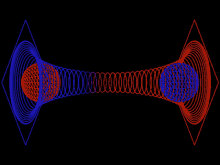And luckily for us, quantum physicists think they know how to reach that higher dimension.
Key Takeaways:
- Scientists believe wormholes, theoretical tunnels through spacetime, might allow near-instant travel across galaxies.
- To access wormholes, we may need to tap into a higher-dimensional space beyond our current understanding.
- Hypothetical exotic matter with negative mass could keep a wormhole stable, preventing it from collapsing under intense gravitational forces.
- Tiny, temporary wormholes, or “quantum foam,” might exist at microscopic scales, offering a potential foundation for larger, stable wormholes.
- Wormhole travel could distort time, allowing for forward or backward travel depending on how spacetime is manipulated.
___________

Interstellar travel could become a reality, but only if we can harness higher dimensions beyond our three-dimensional experience, scientists suggest. Recent theories propose that wormholes—spacetime shortcuts—might allow humans to traverse vast cosmic distances, connecting different parts of the universe nearly instantaneously. However, accessing these wormholes requires a breakthrough: tapping into a higher-dimensional realm.
Wormholes: A Possible Pathway Through Higher Dimensions
Wormholes are theoretical constructs based on Einstein’s General Relativity principles, first explored by Einstein and Nathan Rosen in 1935 as “Einstein-Rosen bridges.” These wormholes could act as tunnels linking two far-apart regions in spacetime, effectively bending the “fabric” of space. If these wormholes exist, they are thought to connect points separated by enormous distances, potentially galaxies apart, allowing for interstellar travel that otherwise would take thousands of years at light speed.
Scientists often use a familiar analogy to explain this phenomenon: imagine folding a two-dimensional piece of paper so two distant points touch, then puncturing it with a pencil to form a bridge between them. Similarly, a wormhole could theoretically connect two points in our universe. However, this shortcut would only be possible if we could enter a higher-dimensional space beyond our own three-dimensional experience. In other words, we’d need to “break into” this higher dimension, where such a wormhole bridge would likely exist, and then use it to travel instantly to distant cosmic locations.
Stability Challenges and the Need for Exotic Matter
To make a wormhole viable for interstellar travel, it would need to be held open by a type of material scientists refer to as “exotic matter.” Unlike ordinary matter, which has positive mass and is governed by gravity, exotic matter would have negative mass and might counteract gravity’s intense pull within the wormhole, preventing it from collapsing. Without exotic matter, the immense gravitational forces near a wormhole would likely tear it apart or cause it to implode soon after forming.
Theoretical physicist Kip Thorne, who worked as a science advisor for the movie Interstellar, points out that while creating a stable wormhole may sound far-fetched, it’s not entirely impossible. The use of exotic matter, while hypothetical, is a potential solution for keeping a wormhole open long enough for passage. If scientists can eventually produce or find exotic matter, it could act as a scaffold to stabilize the wormhole’s “throat” and prevent it from collapsing under gravitational forces.
You May Also Like:
- China’s ‘artificial sun’ reactor achieved its first magnetic field milestone in fusion science
- NASA reveals how Jupiter grew by consuming rocky planetesimals in its early years
- Astrobiologists propose that Earth itself could be an intelligent entity
Entering the Realm of Quantum Physics and Time Distortion
Another dimension where wormholes might already exist is on a quantum scale. Quantum theory suggests that tiny, brief wormholes—or “quantum foam”—may spontaneously form and disappear at microscopic levels. Capturing one of these wormholes and enlarging it could theoretically open a door for larger-scale travel, but this would require technology far beyond our current capabilities. This small, theoretical gateway could be the first step toward creating a stable wormhole suitable for human travel.
Traveling through a wormhole would also have peculiar effects on time, as spacetime itself would be warped. For example, time might flow differently on each side of the wormhole. If one side moves faster than the other, travelers might experience time distortion, emerging at a different time than when they entered. Thorne and other scientists have suggested that a sufficiently large wormhole could even allow for backward time travel, depending on how it interacts with the universe’s spacetime structure.





My Uncle was a professional Physicist, worked on the Manhattan Project, etc. 50 years ago he told me about the theoretical Quantum Physics & how that would apply to time travel… He explained how it was theoretically possible, they basically knew how to do it, but they didn’t have the necessary gear developed yet. Well, now it’s 50 later… & it sounds like the gear’s finally catching up.
They know how, but it’ll require harnessing the entire power of the sun, which is totally impossible so completely irrelevant.
I don’t understand how exactly this “Einstein-Rosen bridge” explains the teleportation between the two ends of the wormhole, which is why I doubt that even moving to a higher dimension can help.
Belief has been known to change things as long as people “exude” it. That goes for things that aren’t the same until they are viewed (or believed) or things that are the makings of miracles like prayer (or believed).